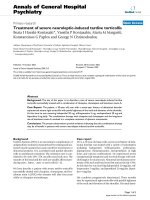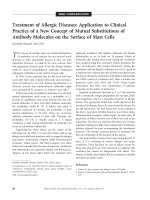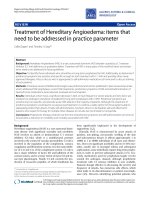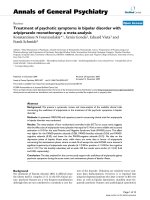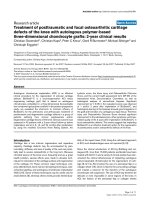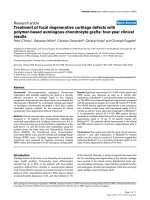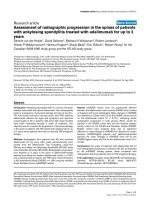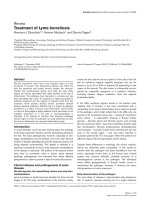Báo cáo y học: "Treatment of euvolemic hyponatremia in the intensive care unit by urea" docx
Bạn đang xem bản rút gọn của tài liệu. Xem và tải ngay bản đầy đủ của tài liệu tại đây (349.9 KB, 6 trang )
RESEARC H Open Access
Treatment of euvolemic hyponatremia in the
intensive care unit by urea
Guy Decaux
1*
, Caroline Andres
1
, Fabrice Gankam Kengne
1
, Alain Soupart
1,2
Abstract
Introduction: Hyponatremia in the intensive care unit (ICU) is most commonly related to inappropriate secretion
of antidiuretic hormone (SIADH). Fluid restriction is difficult to apply in these patients. We wanted to report the
treatment of hyponatremia with urea in these patients.
Methods: Two groups of patients are reported. The first one is represented by a retrospective study of 50
consecutive patients with mild hyponatremia treated with urea. The second group is presented by a series of 35
consecutive patients with severe hyponatremia acquired outside the hos pital (≤ 115 mEq/L) who where treated by
isotonic saline and urea (0.5 to 1 g/kg/day), administered usually by gastric tube.
Results: In the first group with mild hyponatremia (128 ± 4 mEq/L) the serum sodium (SNa) increased to a mean
value of 135 ± 4 mEq/L (P < 0.001) after two days of urea therapy (46 ± 25 g/day), despite a large fluid intake (> 2
L/day). The mean duration of urea therapy was six days (from 2 to 42 days). Six patients developed hyponatremia
again once the urea was stopped, which necessitated its reintroduction. Six patients developed hypernatremia
(maximum value 155 mEq/L). In the second group, SNa increased from 111 ± 3 mEq/L to 122 ± 4 mEq/L in one
day (P < 0.001). All the patients with neurological symptoms made a rapid recovery. No side effects were observed.
Conclusions: These data show that urea is a simple and inexpensive therapy to treat euvolemic hyponatremia in
the ICU.
Introduction
In the intensive care unit, hyponatremia occurs fre-
quently and is associated with an increased mortality
[1-4]. It is mostly related to the presen ce of inappropri-
ate antidiuresis due to an excess of ADH. Management
of this condition usually implies water restriction. This
is of poor applicability in patients requiring multiple
intravenous medications and/or nutritional support.
Recently a new class of drugs antagonizing the V2
receptor (V2RA) has been developed: the vaptans [5-9].
Two of t hem are already avai lable on the market:
Conivaptan for the intravenous route [10-16] and Tol-
vaptan for the oral route [17]. The present data recall
that urea is an effective and easy therapeutic choice to
correct hyponatremia related to SIADH [18-21] with
special attention for patients in the intensive care unit.
The main criticism to the use of urea orally is its taste;
this is not a problem in the intensive care unit as it is
usually administered by gastric tube or intravenously.
No prospective data comparing V2 antagonists to urea
are available. We present a large retrospective series of
patients with moderate or severe hyponatremia treated
with urea and shows that its use is a easy, save and
inexpensive treatment.
Materials and methods
Study I - Moderate hyponatremia (120 to 134 mmol/L)
We analyzed the charts of 50 consecutive patients trea-
ted with urea in the intensive care unit.
Some serum parameters two days before and the first
two days during urea therapy are presented (Figure 1).
In 10 patients, urine parameters and balance data were
also available (see Table 1). All the patients were receiv-
ing isotonic or half isotonic saline solutio ns before urea
administration.
Pharmaceutical grade urea (medicinal urea, Certa®,
Braine l’Alleud, Belgium) is usually pre pared by the
* Correspondence:
1
Research Unit on Hydromineral Metabolism, Department of General Internal
Medicine, University Erasme Hospital, ULB, Route de Lennik 808, Brussels,
B-1070, Belgium
Full list of author information is available at the end of the article
Decaux et al. Critical Care 2010, 14:R184
/>© 2010 Decaux et al.; licensee BioMed Central Ltd. This is an open access a rticle distri buted under the terms of the Creative Co mmons
Attribution License ( which permits unrestricted use, distribution, and reproduction in
any medium, provided the original work is properly ci ted
pharmacy in bags of 15 or 30 g [22], which are dissolved
in 100 ml water and given by gastric tube over 5 to 10
minutes (except in ca se of brain haemorrhage in whic h
urea is given continuously). In some patients urea is
directly dissolved in the liquid nutritional support.
Patients taking it orally dissolved urea in orange juice
(or syrup) and take it after the meal.
Study II - Severe hyponatremia (≤ 115 mmol/L)
We analyzed the records of 35 consecutive patients with
severe hyponatremia treated with urea (Figure 2a).
In 12 of these patients urea was added 24 hr after 1 or
2 L isotonic saline (Figure 2b).
In 10 patients, SNa and S urea were measured before an d
every 4 hr after urea (0.5 g/kg/12h) administration combined
with perfusion of 1 L isotonic s aline each 12 hr (Figure 2c).
In all the patients SNa was measured at least two
times (a few hours to 24 hrs before urea therapy).
For Studies I and II, an ethical approval was obtained.
Dataareprovidedasmean±SD,weusetheone-way
analysis of varia nce and the Tukey-Kramer mult iple
comparisons test.
Figure 1 Evolution of SNa and blood urea in 50 patients before and after urea therapy.
Table 1 Evolution of some blood and urine parameters in 10 patients with mild hyponatremia treated by 45 g urea/
daily at least during three days
Day -1 Day 0 Day 1 Day 2
S Urea (mg/dL) N < 40 25 (± 10.1) 25 (± 9.5) 60 (± 25.9)* 67 ± 29.7*
S Creat (mg/dL) N < 1.1 0.5 (± 0.1) 0.5 (± 0.1) 0.5 (± 0.1) 0.5 (± 0.1)
S Na (mmol/L) 133 (± 1.3) 130 (± 1.8) 132 (± 3.7) 136 (± 5.0)*
S K (mmol/L) 4 (± 0.4) 4 (± 0.3) 4 (± 0.3) 4 (± 0.3)
U Osm (mosmol/kg) 587 (± 153.3) 623 (± 136.5) 637 (± 112.2) 690 (± 122.0)
U Urea (mg/dL) 938 (± 511.4) 1031 (± 476.8) 1806 (± 461.6)* 2187 (± 534.1)*
U Creat (mg/dL) 44 (± 25.5) 45 (± 23.0) 30 (± 15.0) 29 (± 16.3)
U Na (mmol/L) 127 (± 32.9) 139 (± 43.2) 112 (± 44.0) 93 (± 39.0)
FE.Na (%) N < 1.5% 1.2 (± 0.6) 1.2 (± 0.5) 1.51 (± 0.9) 1.31 (± 0.6)
FE.Osm (%) N < 3% 2.38 (± 0.6) 2.45 (± 0.5) 3.99 (± 1.8)* 4.62 (± 1.6)*
*P < 0.01 compared to day 0.
S, serum; U, urine; FE.Na, fractional sodium excretion; FE.Osm, fractional osmolytes excretion.
To convert S urea (mg/dl) in BUN (mg/dl) multiplied by 0.467.
Decaux et al. Critical Care 2010, 14:R184
/>Page 2 of 6
Results
Moderate hyponatremia
Figure 1 presents the evolution of SNa and S.urea in 50
patients treated by urea for mild hyponatremia devel-
oped it in the intensive care unit (mean age: 71 ± 20
years). Two-thirds of the patients were receiving isotonic
saline (1 or 2 L/day) and one-third received half isotonic
saline (1 or 2 L) during the two days before and after
urea administration. It is usual in our intensive care unit
that when infusion induced or aggravated hyponatremia
to add urea, while maintaining the same volume of
liquid administration (liquid nutritional support, medi-
cation, and so on).
SNa increased significantly in all the patients (ΔSNa in
two days: 7 ± 4 mEq/L; P <0.001)).Thedoseofurea
varied between 15 and 120 g/day given usually by gastric
tube in one to four doses. The mean dose was 46 ± 25
g/day. Ten patients received 15 g/day, 10 receiv ed 30 g/
day, 11 re ceived 45 g (usually 3 × 15 g/day), 14 received
60 g/day, 3 received 90 g/day and 2 received 120 g/day.
Urea was given by gastric tube in 80% of the patients
and by mouth in 20%.
Table 1 presents the evolution of some blood and
urine parameters in 10 pa tients where these d ata were
available; all these patients received at least 45 g/day
urea during three days. Table 1 s hows that in these
patients the intake of urea was associated, as expected,
with an increase in urine urea concentration (while
uri ne osmolality remained high ). In those patient s, total
liquid input the first day of urea therapy was estimated
at 3.031 ± 1.244 mL and output was 3,905 ± 1,016 mL
(mean difference 874 mL) (P <0.01)whichcontribute
to the increase in SNa despite the high fluid intake.
The origin of SIADH was due to different brain dis-
eases (tumour, subdural hematoma, subarachnoid hae-
morrhage, brain hematoma, posttraumatic brain injury,
meningitis , and so on) in 80% of the patients and in 20%
vs non brain diseases (neoplasms, pneumonia, COPD,
and so on). Seven patients developed hypernatremia dur-
ing urea therapy (maximum value of SNa 155 mEq/L).
Figure 2 Evolution of SNa in 35 patients with severe hyponatremia treated by urea and isotonic saline. (a) Daily evolution of SNa (mean
± SD) in 35 patients with severe hyponatremia (≤ 115 mEq/L) treated with isotonic saline and urea (*P < 0.001 compared to Day 0). (b) Daily
evolution of SNa (mean ± SD) in 12 patients with severe hyponatremia (≤ 115 mEq/L) who received the first day only isotonic saline (1 or 2 L).
The addition of urea increased significantly SNa (*P < 0.01 compared to Day 0). (c) Evolution of SNa (mean ± SD) each four hours in 10 patients
with severe hyponatremia treated with 1 L isotonic saline over 12 hr and urea (0.5 g/kg) (P < 0.01 compared to time 0).
Decaux et al. Critical Care 2010, 14:R184
/>Page 3 of 6
The dose of urea was adjusted by the intensivists
depending of the increase in SNa.
Mean duration of treatment was six days (from 2 to
42 days in the ICU). Hyponatremia recurred in six
patients when urea was stopped, which necessitated its
reintroduction.
Severe hyponatremia
Figure 2a presents the evolution of SNa in 35 patients
with severe hyponatremia which was acquired outside
the hospitals (in 10 patients it was due to thiazides, in 8
to neoplasic diseases, and so on). Most patients pre-
sented neurological symptoms (four were asymptomatic,
four were comatose, three presented seizures, all the
other were described as confused or somnolent). SNa
increased from 111 ± 3 mEq/L to 122 ± 4 mEq/L in
one day (P < 0.001) and all the patients with neurologi-
cal symptoms made a rapid recovery.
SNa increased more than 12 mmol/L the first day in
12 patients and in 13 patients the increase in SNa was
higher than 18 mmol/L/48 hr. In two of these patients
the intensivist lowered the SNa again by giving desmo-
pressin (DDAVP) and water. No cases of clinical osmo-
tic demyelination syndrome (ODS) developed. When
high doses of urea are used (≥ 60 g/day) it is usual to
avoid the next dose of urea if blood urea level is higher
than 150 mg/dL (SNa and urea are measured in most
patients every 8 to 12 hr when large doses are used). No
cases of hypernatremia were observed. The 10 patients
with thiazides induced hyponatremia presented biologi-
cal data similar to patients with SIADH (low urea and
uric acid levels) [23,24]; it is likely that isotonic saline
alone was sufficient in most of these patients.
Seven patients presented hypokaliemia (range 2.3 to
3.4 mmol, four were taking diuretics).
All the patients pr esented with a systolic blood pres-
sure over 100 mmHg and showed no signs of overt
hypovolemia (clinically or biologically).
In 12 patients (Figure 2b) urea therapy was initiated
after 1 or 2 L isotonic saline (given over one day) and
which did not improved natremia (two were o n
thiazide).
In 10 patients (Figure 2c), 1 L isotonic saline was
administered each 12 hr with 0.5 g/kg of urea (given by
mouth or gastric tube). In these patients, mean SNa
increased by 7 ± 4 mmol/L in eight hours (range 1 to
11 mmol/L; P < 0.01). Urea increased from 27 ± 14 mg/
dL to 96 ± 30 mg/dL four hours after urea administra-
tion (P < 0.001).
Discussion
Our data show that urea is an efficient and safe method
to manage hyponatremia in the intensive care unit. Urea
has been used orally or intravenously over time as an
osmotic diuretic drug and as an agent to reduce intra-
cranial and intraocular pressure [25]. As opposed to
mannitol, urea enters intracellular spaces rapidly (in less
than one hour) throughout the body, decreasing the
immediate risk of sudden cardiac decompensation due
to rapid intravascular volume expansion and does not
induce a transient decrease in SNa as observed with
mannitol (translocation hyponatremia) [26]. However,
because urea penetrates into the CNS only about one-
tenth as quickly as into muscle, a significant intravascu-
lar to CNS urea gradient occurs (during 4 to 10 hrs)
[27]. Decreases in brain water content and intracranial
pressure during urea administration have been measured
experimentally and/or clinically [25].
In this study, urea was not used to treat eventual brain
oedema due to hyponatremia [28,29].
High doses of urea can be given on a long-term basis
without renal toxicity which is not the case for manni-
tol. In individuals with previously n ormal baseline renal
function, the mean total dose of mannitol that precipi-
tated acute renal failure was 626 ± 270 g over two to
five days [30] (which represents about 209 g ± 90 g urea
on an equimolar basis).
Many patients presented hyponatremia associated with
variousbraindiseases,itislikelythatmostpresented
SIADH as isotonic saline infusion (2/3 of the patients)
or half-isotonic saline (1/3 of the patients) was not able
to correct SNa [31], while the introduction of urea cor-
rected SNa (Figures 1 and 2b).
ThemeanincreaseinSNawasaround4mmol/Lthe
first day of urea admini stration and 7 mmol/L in 48 hrs
in the patients with mild hyponatremia, these results are
similar to those reported with conivaptan whether used
orally or intravenously [10-16]. In our study there was
no fluid restriction, while in the conivaptan studies fluid
intake was less than 2 L/day. Conivaptan is a substrat e
and potent inhibitor of the microsomal enzyme cyto-
chrome P450 (CYP) 3A4, the concomitant use of several
agents are prohibited, including chemotherapeutic
agents, calcium c hannel blockers, 3-hydroxy-3 methyl-
glutaryl-coenzyme A reductase inhibitors, benzodiaze-
pines, and immunosuppressants. Use of conivaptan has
been allowed for four-days treatment and by the intrave-
nously route. Another anti V2 medication need to be
used for patients with persistent SIADH (which is fre-
quent) while urea has no long-term toxicity [25,32,33]
and can also be used intravenously, although in the pre-
sent study the 85 patients with hyponatremia were all
treated orally (less expensive than the intravenous route;
for example Ureaphil where each bottle of 135 mL con-
tains 40 g urea which need to be dissolved in 5% dex-
trose) [19,22]. In the large SALT trials with Tolvaptan,
patients had free access to water but first day of treat-
ment SNa increases of about 2 to 3 mmol/L and about
Decaux et al. Critical Care 2010, 14:R184
/>Page 4 of 6
7 mmol/L at the end of the study on Day 30 [17]. We
did not include in this study patients with symptomatic
acute hyponatremia (mainly postoperative). All our
patients with severe hyponatremia developed it outside
the hospital and are considered as a t least partially,
chronically hyponatremia (> 48 hr) and no patients pre-
sented with primary polydipsia.
In this series of severe hyponatremic patients, only
four were frankly comatose but the majority were symp-
tomatic and were treated by isotonic saline combined
with urea given o rally (by gastric tube if needed). In our
hospital severe euvolemic hyponatremia is usually trea-
ted with a combination of urea and isotonic saline
which is an alternative to hypertonic saline [21]. At the
present time, severe symptomatic hyponatremia particu-
larly if epileptic seizures are present should be treated
with hyperton ic saline (consensus conference) [34].
Hypertonic saline will increase SNa theoretically more
rapidly than urea.
Establishment of a depletional origin of hyponatremia
is not always easy particularly in the medical ward
[35,36]. The combined treatment of isotonic saline and
urea has some advantages. If there is some salt d eple-
tion, isotonic saline will be useful while if exc ess water
is the main factor of hyponatremia, urea will be useful
(by subtracting water).
Although we discourage an increase of SNa of more
than 10 mmol/L/day, many patients presented a too
large increase [21, 22,34]. We know that urea has a pro-
tective effect against osmotic demyelination syndrome
(ODS) in animals [37-40]. SNa was decreased again only
in two patients by giving DDAVP and water [41-44]. No
clinically cases of ODS were observed in our patients,
this could reflect the protective effect of urea.
In all the studies published with the vaptans, no
patients with SNa less than 115 mEq/L where included.
Despite the attractiveness of using a pure aquaretic
agent to correct life-threatening hyponatremia, insuffi-
cient data are available from clinical trials to know if
sufficiently rapid correction can be achieved in patients
with acute, severe hyponatremia without the use of
hypertonic saline. Indeed, present studies show that
V2RA diuresis does not begin to increase before one to
two hours.
Urea in large doses (1 g/kg), when administered rapidly
by gastric tube in a matter of minutes, has a p urgative
effect which creates troublesome nursing problems in the
comatose patients. This effect could be avoided by
administering the urea over a long period of time, or by
fractioning the dose. In our study, this was never a p ro-
blem; no tracheal aspiration was reported, but we avoided
giving urea rapidly in large amounts. We also adminis-
tered urea continuously (for example in the liquid nutri-
tional support) in patients with brain haemorrhage, to
avoid any brain shrinkage. As previously mentioned, urea
was not used to treat brain oedema in this study
(although this could represent a good indication, particu-
larly if the intravenous route is used) [21]. We can expect
that acute administration of urea at 0.5 gr/kgBW intrave-
nouslyoveronehourororallywillrapidly(onehour)
increase serum osmolality by 15 mOsm/kg/H
2
O during a
few hours (renal elimination).
These data report the use of urea in an intensive care
unit, but urea can also be used to treat many patients
over the long -term (years) without problems and likely
with similar efficacy than the V2 antagonists but at a
much lower price [45]. In many patients, taste is not a
complaint, particularly if low doses are sufficient to con-
trol hyponatremia (15 to 30 g/day).
Conclusions
These data emphasise tha t urea combined with isotonic
saline is an easy way to treat euvolemic hyponatremia in
the ICU.
A prospective treatment comparing this old treatment
with the V2RA needs to be done.
Key messages
• In the intensive care unit, urea combined with iso-
tonic saline is an easy and inexpensive way to treat
euvolemic hyponatremia.
Abbreviations
DDAVP: desmopressin; FE.Na: fractional excretion of sodium (in %); FE.osm:
fractional excretion of osmoles (in %); ODS: osmotic demyelination
syndrome; SIADH: syndrome of inappropriate secretion of ADH; SNa: serum
sodium; V2RA: V2 receptor antagonist.
Acknowledgements
We are indebted to Serge Brimouille for helpful discussions. This study was
supported by a grant from the Fonds National de la Recherche Scientifique
(FNRS), convention n°3.4656.09.
Author details
1
Research Unit on Hydromineral Metabolism, Department of General Internal
Medicine, University Erasme Hospital, ULB, Route de Lennik 808, Brussels,
B-1070, Belgium.
2
Department of Internal Medicine, Tubize-Jolimont Hospital,
Avenue de Scandiano 8, Tubize, B-1480, Belgium.
Authors’ contributions
All the authors contributed to the collection and analyse of the data in a
similar way. All authors read and approved the final manuscript.
Competing interests
The authors declare that they have no competing interests.
Received: 23 February 2010 Revised: 25 May 2010
Accepted: 14 October 2010 Published: 14 October 2010
References
1. Palmer BF: Hyponatremia in the intensive care unit. Semin Nephrol 2009,
29:257-270.
2. De Vita MV, Gardenswartz MH, Konecky A, Zabetakis PM: Incidence and
etiology of hyponatremia in an intensive care unit. Clin Nephrol 1990,
34:163-166.
Decaux et al. Critical Care 2010, 14:R184
/>Page 5 of 6
3. Stelfox MT, Ahmed SB, Khandwala F, Zygun D, Shahpori R, Lauplan K: The
epidemiology of intensive care unit-acquired hyponatremia and
hypernatremia in medical-surgical intensice care units. Crit Care 2008, 12:
R162.
4. Wald R, Jaber BL, Price LL, Upadhyay A, Madias NE: Impact of hospital-
associated hyponatremia on selected outcomes. Arch Intern Med 2010,
170:294-302.
5. Gross P, Marczewski T, Herbrig K: The vaptans ante portas: a status report.
Nephrol Dial Transplant 2009, 24:1371-1373.
6. Chen S, Jalandhara N, Battle D: Evaluation and management of
hyponatremia: an emerging role for vasopressin receptor antagonists.
Nat Clin Pract Nephrol 2007, 3:82-95.
7. Quitbnat F, Gross P: Vaptans and the treatment of water-retaining
disorders. Semin Nephrol 2006, 26:234-243.
8. Greenberg A, Verbalis JG: Vasopressin receptor antagonists. Kidney Int
2006, 69:2124-2130.
9. Decaux G, Soupart A, Vassart G: Non-peptide arginine-vasopressin
antagonists: the vaptans. Lancet 2008, 371:1624-1632.
10. Ghali JK, Koren MJ, Tayor JR, Brooks-Asplund E, Fan K, Long WA, Smith N:
Efficacy and safety of oral conivaptan: a V1A/V2 vasopressin receptor
antagonist, assessed in a randomized, placebo-controlled trial in patiens
with euvolemic or hypervolemic hyponatremia. J Clin Endocrinol Metab
2006, 91:2145-2152.
11. Decaux G: Long-term treatment of patients with inappropriate secretion
of antidiuretic hormone by the vasopressin receptor antagonist
conivaptan, urea, or furosemide. Am J Med 2001, 110:582-584.
12. Zeltser D, Rosansky S, van Rensburg H, Verbalis JG, Smith N, Conivaptan
Study Group: Assessment of the efficacy and safety of intravenous
conivaptan in euvolemic and hypervolemic hyponatremia. Am J Nephrol
2007, 27:447-457.
13. Verbalis JG, Zeltser D, Smith N, Barve A, Andoh M: Assessment of the
efficacy and safety of intravenous conivaptan in patients with
euvolaemic hyponatremia: subgroup analysis of a randomized,
controlled study. Clin Endocrinol (Oxf) 2008, 69:159-168.
14. Ananne D, Decaux G, Smith N, Conivaptan Study Group: Efficacy and
safety of oral conivaptan, a vasopressin-receptor antagonist, evaluated
in a randomized, controlled trial in patients with euvolemic or
hypervolemic hyponatremia. Am J Med Sci 2009, 337:28-36.
15. Murphy T, Dhar R, Diringer M: Conivaptan bolus dosing for the correction
of hyponatremia in the neurointensive care unit. Neurocrit Care 2009,
11:14-19.
16. Velez JC, Dopson SJ, Sanders DS, Delay TA, Arthur JM: Intravenous
conivaptan for the treatment of hyponatremia caused by the syndrome
of inappropriate secretion of antidiuretic hormone in hospitalized
patients: a single-centre experience. Nephrol Dial Transplant 2010,
25:1524-1531.
17. Schrier RW, Gross P, Gheorghiade M, Berl T, Verbalis JG, Czerwiec FS,
Orlandi C, Salt Investigators: Tolvaptan, a selective oral vasopressin V2-
receptor antagonist, for hyponatremia. N Engl J Med 2006, 355:2099-2112.
18. Decaux G, Brimioulle S, Genette F, Mockel J: Treatment of the syndrome
of inappropriate secretion of antidiuretic hormone by urea. Am J Med
1980, 69:99-106.
19. Decaux G, Unger J, Brimioulle S, Mockel J: Hyponatremia in the syndrome
of inappropriate secretion of antidiuretic hormone. Rapid correction
with urea, sodium chloride, and water restriction therapy. JAMA 1982,
247:471-474.
20. Decaux G, Genette F: Urea for long-term treatment of the syndrome of
inappropriate secretion of antidiuretic hormone. Br Med J (Clin Res Ed)
1981, 283:1081-1083.
21. Decaux G, Soupart A: Treatment of symptomatic hyponatremia. Am J Med
Sci 2003, 326:25-30.
22. Decaux G, Musch W, Soupart A: Hyponatremia in the intensive care: from
diagnosis to treatment. Acta Clinica Belgica 2000, 55:68-78.
23. Decaux G, Schlesser M, Coffernils M, Prospert F, Namias B, Brimioulle S,
Soupart A: Uric acid, anion gap and urea concentration in the diagnosis
approach to hyponatremic patients. Clin Nephrol 1994, 42:102-108.
24. Fenske W, Stork S, Koschker AC, Blechschmidt A, Lorenz D, Wortmann S,
Allolio B: Value of fractional uric acid excretion in differential diagnosis
of hyponatremic patients on diuretics. J Clin Endocrinol Metab 2008,
93:2991-2997.
25. Javid M: Urea - new use of an old agent. Reduction of intracranial and
intraocular pressure. Surg Clin North Am 1958, 38:907-928.
26. Buckell M: Blood changes on intravenous administration of mannitol or
urea for reduction of intracranial pressure in neurosurgical patients. Clin
Sci 1964, 27:223-227.
27. Kleeman CR, Daison H, Levin E: Urea transport in the central nervous
system. Am J Physiol 1962, 203:739-747.
28. Decaux G, Szyper M, Grivegnée A: Cerebral ventricular volume during
hyponatremia. J Neurol Neurosurg Psychiatry 1983, 46:443-445.
29. Porzio P, Halberthal M, Bohn D, Halperin ML: Treatment of acute
hyponatremia: ensuring the excretion of a predictable amount of
electrolyte-free water. Crit Care Med 2000, 28:1905-1910.
30. Dorman HR, Sondheiner JH, Cadnapahornchai P: Mannitol induced acute
renal failure. Medicine (Baltimore) 1990,
69:153-159.
31. Musch W, Decaux G: Treating the syndrome of inappropriate secretion of
ADH with isotonic saline. QJM 1998, 91:749-753.
32. Verhoeven A, Musch W, Decaux G: Treatment of the polydipsia-
hyponatremia syndrome with urea. J Clin Psychiatry 2005, 66:1372-1375.
33. Kawai N, Ishikawa K, Nemoto K, Katano T, Takahashi S, Hori T, Asada T: Oral
urea treatment for polydipsia-hyponatremia syndrome in patients with
schizophrenia. J Clin Psychopharmacol 2009, 29:499-501.
34. Verbalis JG, Goldsmith SR, Greenberg A, Schrier RW, Sterns RH:
Hyponatremia treatment guidelines 2007: expert panel
recommendations. Am J Med 2007, 120:S1-S21.
35. Decaux G, Musch W: Clinical laboratory evaluation of the syndrome of
inappropriate secretion of antidiuretic hormone. Clin J Am Soc Nephrol
2008, 3:1175-1184.
36. Musch W, Thimpont J, Vandervelde D, Vanhaeverbeke I, Berghmans T,
Decaux G: Combined fractional excretion of sodium and urea better
predicts response to saline in hyponatremia than do usual clinical and
biochemical parameters. Am J Med 1995, 99:348-355.
37. Soupart A, Stenuit A, Perier O, Decaux G: Limits of brain tolerance to daily
increments in serum sodium in chronically hyponatremic rats treated by
hypertonic saline or urea. Clin Sci (Lond) 1991, 80:77-84.
38. Soupart A, Penninckx R, Stenuit A, Decaux G: Azotemia (48 h) decreases
the risk of brain damage in rats after correction of chronic
hyponatremia. Brain Res 2000, 852:167-172.
39. Soupart A, Silver S, Schroeder B, Sterns R, Decaux G: Rapid (24-hour)
reaccumulation of brain organic osmolytes (particularly myo-Inositol) in
azotemic rats after correction of chronic hyponatremia. J Am Soc Nephrol
2002, 13:1433-1441.
40. Soupart A, Schroeder B, Decaux G: Treatment of hyponatremia by urea
decreases risks of brain complications in rats, a brain osmolyte contents
analyses. Nephrol Dial Transplant 2007, 22:1856-1863.
41. Soupart A, Penninckx R, Crenier L, Stenuit A, Perier O, Decaux G: Prevention
of brain demyelination in rats after excessive correction of chronic
hypontremia by serum sodium lowering. Kidney Int 1994, 45:193-200.
42. Soupart A, Penninckx R, Stenuit A, Decaux G: Reinduction of hyponatremia
improves survival in rats with myelinolysis related neurologic symptoms.
J Neuropathol Exp Neurol 1996, 55:594-601.
43. Gankam Kengne F, Soupart A, Pochet R, Brion JP, Decaux G: Re-induction
of hyponatremia after rapid overcorrection of hyponatremia reduces
mortality in rats. Kidney Int 2009, 76:614-621.
44. Perianayagam A, Sterns RH, Silver SM, Grieff M, Mao R, Hix J, Konides R:
DDAVP is effective in preventing and reversing inadevertent
overcorrection of hyponatremia. Clin J Am Soc Nephrol 2008, 3:331-336.
45. Soupart A, Decaux G:
Efficacy and tolerance of vaptans compared to urea
for long-term treatment of patients with SIADH: a prospective study.
Acta Clinica Belgica 2009, 64:563, (abstract).
doi:10.1186/cc9292
Cite this article as: Decaux et al.: Treatment of euvolemic hyponatremia
in the intensive care unit by urea. Critical Care 2010 14:R184.
Decaux et al. Critical Care 2010, 14:R184
/>Page 6 of 6

